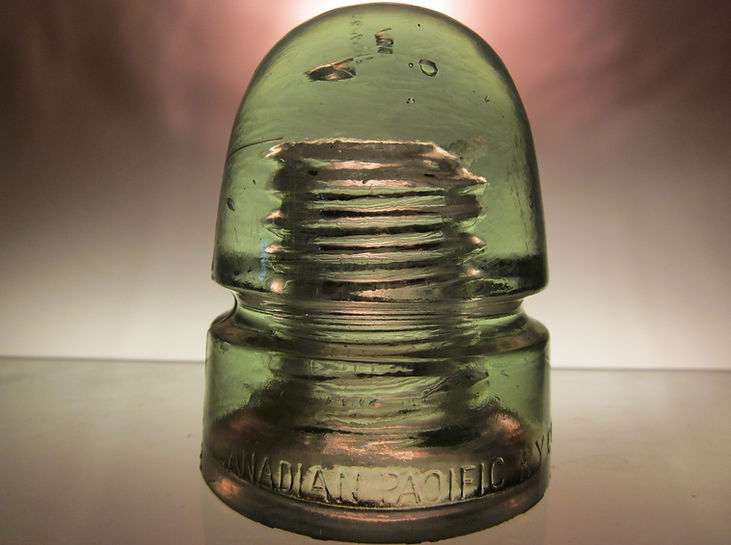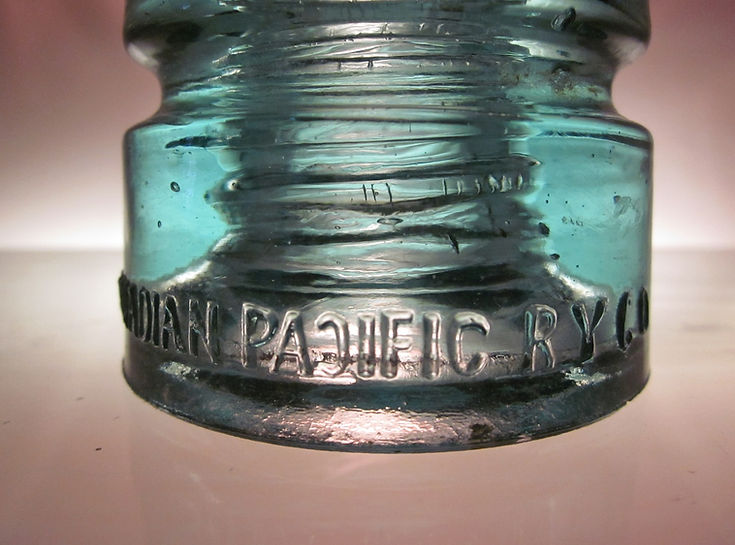MOULD WEAR AND RE - ENGRAVING
Mould wear and the need to re engrave the embossing on insulators depended on many factors.
Pre 1900 hand press moulds were often of lesser quality than the later machine press ones . Although many Canadian insulators continued to be hand pressed till at least 1926.
In the U.S. large companies focused on insulators and could afford to replace moulds more often than in Canada where it was the glass works that had the moulds and sold to the end user. I have no doubt that even the U.S. moulds show signs of re-engraving.
I find that in the CD 143 Canadian insulators with mould line over the dome , most were re-engraved , some of them twice.
Below is the CD 143 ( 090 ) CAN PAC on a raised band. This is not a slug plate which would have been a removable plate to interchange for different embossings. It is instead where previous engraving was ground away.
The pic on the left is a fresh mould , the right one is a little worn.
I used the square dome mould for this post. there is also a round dome mould in this group.

The view below shows this raised band ( square dome ) as being the mould that in the first small batch that were pressed , had a band that ended before the mould line of the front half of the mould . These are very tough to come by. This was changed to a mould line to mould line band after possibly just one day.
The second mould ( round dome ) in the ( 090 ) raised band had a band that went mould line to mould line from the start.

Below is a partially worn mould next to a very worn one.
These moulds over the 5-6 years of use made 10's of thousands of insulators. On the left the band has lost it's sharp edges and has a slight bevel making it wider than the original . By the time the one on the right is made the band is very rounded and much wider , the letters are for the most part gone . The skirt has been shortened and there have been repairs done to both sides at the base on the mould line. Notice also the wire groove becomes narrower , this is from wear and cleaning of the ridge in the mould that forms the wire groove. Also there are vertical lines in the wire groove caused by the same ridge getting fractures that the glass is forced into.

Below we have the almost gone to virtually no embossing . The band is not only rounded but because the skirt has been sanded over time it doesn't protrude out much , especially in the center of the mould half.

Below on the left is almost no embossing and the re-engraved one. Almost no band in the center and rounded band near mould lines.

Below is the original with the re-engraved one

Below is the re engraved one . This is the best blue I have seen , it is a light sapphire blue.
I put forward this pair of raised band moulds because they show a gradual deterioration of the mould , not a filling of the engraving with paste as this would mean the moulds were not cleaned for four years.
In the two moulds that make up the raised band group both of the moulds were machined out from the base to the wire groove . This makes them a little larger in circumference . The original moulds were 4 & 3/8th inches from mould line to mould line . The reworked moulds measure 4 & 1/2 inches. I have used the square dome mould for this post . In the rework of this mould the engraving is all new , not over the original letters .
There is also a round dome mould in this group , it's engraving is redone over the original embossing with a period added after the RY. .

>>>>>>>>>>>>>>>>>>>>>>>>>>>>>>>>>>>>>>>>>>>>>>>>>>>>>>>>>>>>>>>>>>>>>>>>>>>>>>>>>>>>>>>>>
I now leave the one above and will show a later Canadian Pacific Ry Co .
This is the backwards C in Pacific CD 143 ( 070 ) This mould while not in the book as part of a set is one of three moulds in a set .
Note . In this set the re-engraving is done directly over the original.
#1 the backwards C ,
# 2 has a slight point on the dome ,
# 3 I just class as the other mould.
Each of these moulds started as light green in many shades . The darker ones are the more difficult to find.
Over a few years the embossing became less clear but was still fully readable.

Below is the embossing at it's weakest , note the difference from the one above.

Below , after re-engraving the mould , the coulors changed to blue aqua pic below on right , small numbers of royal purples , and off clears were made .

Below please forgive the pink back light I need to get a new bulb for the back light

Below is the original embossing , note the smooth arc of the C etc.

Below , Re engraved letters are very different note C and others.

Below, F in original is even with the I , backward C is smooth.

Below , F is slightly taller than the I . Backwards C is rough.

>>>>>>>>>>>>>>>>>>>>>>>>>>>>>>>>>>>>>>>>>>>>>>>>>>>>>>>>>>>>>>>>>>>>>>>>>>>>>>>>>>>>>>>>>
About ten years ago when I did a very in depth study of the CD 143's , I looked into the cast iron moulds that were used for these industrial chunks of glass . I found no evidence of the use of paste in the moulds to which some people attribute the embossing becoming less visible.
What I did find was the term paste mould which applies to a turn mould . I found ( no longer have) a 19th century patent by the Burlington Glass Works in Ontario for putting a hardened paste on the inside of the mould impregnated by saw dust . This was sprayed with water mist before each blow in what is termed a turn mould . It was mainly to make smooth goblet's with no seam lines , but was also used for turn mould bottles . It is accepted by U.S. researchers that most turn mould bottles are not U.S made.
Modern hobby glass blowers and even small companies are now using aluminium moulds that seem to require a release spray . My knowledge in this area is very limited, but modern and even cast moulds for very intricate patterns do not have much to do with a 19th century works where 12 year old boys worked 12 hour days turning out up to a 1000 insulators a day with a hand press.